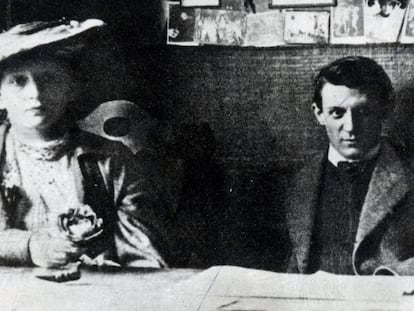Caspar David Friedrich and the melancholic silence of wild nature
Germany is celebrating the 250th anniversary of the quintessential German romantic painter with an ambitious retrospective in Hamburg that brings together his greatest masterpieces
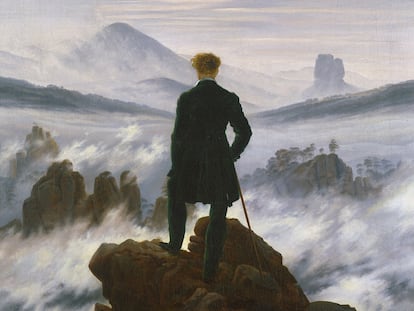

In 1817 the painter Caspar David Friedrich (1774-1840) created what is perhaps the most iconic image of the Romantic movement: Wanderer above the Sea of Fog. It shows the figure of a man standing on a rocky summit, with its back to the observer. In front of him, a huge precipice stretches towards an infinite horizon of mists and steep peaks.
This solitary individual bravely venturing into the wild and uncharted wilderness has been interpreted as a symbol of the search for knowledge, freedom, and communion with nature. In addition to being the quintessential image of the romantic spirit, the Wanderer has become an icon of popular culture, with multiple versions in art, advertising, and social media.
This longing for communion with nature is the common thread of the ambitious retrospective Caspar David Friedrich: Art for a new Age. Organized by the Hamburger Kunsthalle, in Hamburg (Germany), the exhibition commemorates the 250th anniversary of the birth of Friedrich, the German romantic painter par excellence. For the first time in decades, the majority of his greatest masterpieces have been brought together, with 60 paintings and a hundred drawings.
Friedrich made his mark on the history of art with his innovative conception of landscape. He meticulously studied each element of nature, but then recombined them to achieve compositions of intense expressiveness. “This makes nature appear in a particular way. It is convincing and realistic down to the last detail, but at the same time there is a deep and meaningful atmosphere,” says historian and curator of the exhibition Johannes Grave, from the Friedrich-Schiller University Jena in Germany.
The exhibition allows visitors to contemplate Friedrich’s unusual creations: moonlit twilights, gray and ominous skies over troubled seas, solemn fjords, and majestic mountains; all are breathtaking locations, dominated by an eerie atmosphere of silence.
Born in the German city of Greifswald on the Baltic coast, Friedrich trained as an artist in Copenhagen and settled in Dresden. With a melancholic disposition, he lived through the emergence of the romantic movement, whose advance spread rapidly throughout Europe and America at the end of the 18th century. The new rebellious spirit reacted against the rationalism of the Enlightenment and the Industrial Revolution. Faced with growing industrialization and increasing uniformity in society, the romantics promoted a return to primal nature and the singularity of individualism. They longed to experience untamed natural forces and preferred emotion to reason.
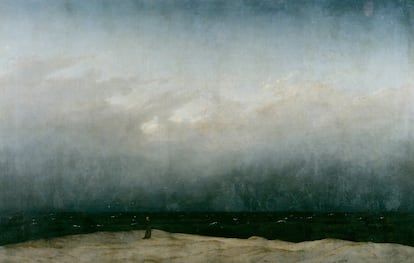
It was on the Baltic island of Rügen, which was beginning to become a tourist destination and which he himself visited on foot several times in the spring of 1801, that Friedrich began to draw landscapes that moved away from traditional motifs. But it was especially at the end of the decade when he painted The Monk by the Sea (1808), which was one of the first masterpieces that earned him resounding success. Its radical composition of beach, sea and sky, arranged in three horizontal stripes, impressed the public and King Frederick William III, who rushed to buy it.
For some experts, its extreme minimalism and abstraction, the solitude of the tiny human figure, and the vastness of nature have made it a precursor of abstract expressionism. “It is romanticism’s Big Bang,” historian Florian Illies summarizes about the painting, in his recent biography of the painter.
This exceptional oil painting, which is one of the exhibition’s featured loans, also presents one of the defining features of Friedrich’s art: contemplative figures with their backs to the observer (Rückenfiguren, in German), absorbed in the natural spectacle. These characters, represented as observed observers, populate some of the painter’s most memorable paintings, such as Hunter in the Forest (1813), and his own Wanderer (1817).
As a good romantic, Friedrich filters the landscape through his freest creative imagination to arouse deep emotions. “It is a great merit, perhaps the greatest of which an artist is capable, when he touches the spirit and provokes thoughts, emotions, and feelings in the observer, even if these are not his own,” wrote Friedrich in his Observations.
Although his iconography is very German — as seen in the mountains and the crosses — Friedrich manages to connect with all audiences, the director of the Hamburger Kunsthalle Alexander Klar points out in a conversation with EL PAÍS: “If you ignore that Germanness, you realize that many of its landscapes are completely devoid of people and at the same time are a reflection of the human being. He speaks a universal language.” Klar emphasizes the exceptional nature of the exhibition: it had not been possible to bring together such a density of works in many years, “and it probably cannot be done again for many more years.”
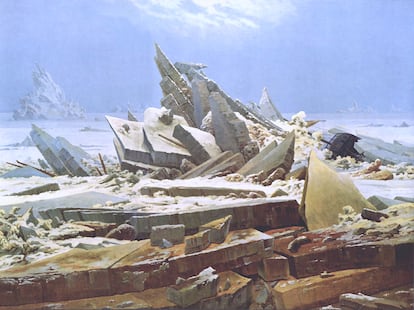
In 1823, the artist painted another of his masterful paintings: The Sea of Ice, in which Friedrich shows a large mass of jagged sea ice. Once again, nature imposes itself on human beings, whose useless efforts are symbolized by the upturned hull of a ship crushed by the ice. The oil painting has been interpreted as a romantic warning to humanity about the futility of attempting to dominate the natural environment.
Friedrich was a successful painter — his clients included members of the courts of Prussia, Thuringia, and the Tsar of Russia — and he exercised some influence among contemporary artists — although Goethe considered him too obscure. Friedrich’s work, however, was ignored for more than half a century until a retrospective in Berlin in 1906 revived interest in the legacy of the great romantic painter, and it was later claimed by the 20th-century avant-garde movement. The Third Reich appropriated his work as an exponent of Germanness, although Hitler had doubts: he did not know if his landscapes elevated the German soul, or rather depressed it a little, as Illies writes.
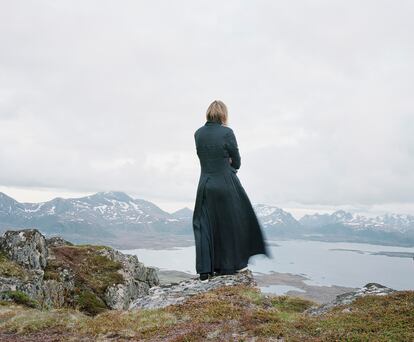
The fascination that Friedrich’s canvases generate to this day is shown in the second part of the exhibition, which brings together contemporary artists who have been inspired by his work, such as Hiroyuki Masuyama, Elina Brotherus, and Olafur Eliasson. The Hamburg exhibition is the figurehead of the Caspar David Friedrich Festival, which will include two other exhibitions on specific aspects of his work in 2024. One will be at the Alte Nationalgalerie, in Berlin, and the other at the Staatliche Kunstsammlungen, in Dresden. Afterward, the exhibition will also travel to the Metropolitan Museum in New York, Klar says.
At the moment, the anniversary of Friedrich’s birth is already spreading through the streets of Hamburg. The city is full of posters announcing the exhibition, of course, with the Wanderer as an attraction on a striking red background. Even a famous hamburger restaurant has dedicated a menu to the romantic painter. In the Portuguese quarter, between the Elbe and the red light district, there is also a large urban mural with the figure painted for the occasion by the Australian artist Fintan Magee. Germany is thus paying tribute to the painter who has best conveyed the vigor and emotion of the romantic spirit through a legacy that is still valid in the popular culture of the 21st century.
Sign up for our weekly newsletter to get more English-language news coverage from EL PAÍS USA Edition
Tu suscripción se está usando en otro dispositivo
¿Quieres añadir otro usuario a tu suscripción?
Si continúas leyendo en este dispositivo, no se podrá leer en el otro.
FlechaTu suscripción se está usando en otro dispositivo y solo puedes acceder a EL PAÍS desde un dispositivo a la vez.
Si quieres compartir tu cuenta, cambia tu suscripción a la modalidad Premium, así podrás añadir otro usuario. Cada uno accederá con su propia cuenta de email, lo que os permitirá personalizar vuestra experiencia en EL PAÍS.
¿Tienes una suscripción de empresa? Accede aquí para contratar más cuentas.
En el caso de no saber quién está usando tu cuenta, te recomendamos cambiar tu contraseña aquí.
Si decides continuar compartiendo tu cuenta, este mensaje se mostrará en tu dispositivo y en el de la otra persona que está usando tu cuenta de forma indefinida, afectando a tu experiencia de lectura. Puedes consultar aquí los términos y condiciones de la suscripción digital.
More information
Últimas noticias
Most viewed
- Sinaloa Cartel war is taking its toll on Los Chapitos
- Oona Chaplin: ‘I told James Cameron that I was living in a treehouse and starting a permaculture project with a friend’
- Reinhard Genzel, Nobel laureate in physics: ‘One-minute videos will never give you the truth’
- Why the price of coffee has skyrocketed: from Brazilian plantations to specialty coffee houses
- Silver prices are going crazy: This is what’s fueling the rally

